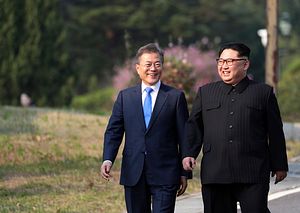The first inter-Korean summit in over a decade is now over. Weeks of build-up resulted in a successful meeting between the leaders of both Koreas. The details of how inter-Korean relations are to proceed in coming weeks and months still need to be nailed down in further meetings. But one thing in clear: South Korea’s strategy to deal with North Korea is engagement. Both the Moon Jae-in government and public opinion agree on this. And this has implications for the planned meeting between U.S. President Donald Trump and North Korean leader Kim Jong-un, as well as for the future of the Korean Peninsula more generally.
President Moon’s preference for engagement is well-known. It was difficult for him to follow this approach while North Korea was conducting a series of missile and nuclear tests throughout 2017. But Moon persevered in extending an olive branch to North Korea. He then grasped the opportunity with both hands as soon as Kim expressed his willingness to explore engagement. The way that talk about a potential “bloody nose” strike on North Korea has led to discussions about the possibility of a peace treaty formally ending the Korean War in a matter of only weeks has been astonishing.
The result is the call for a peace treaty to formally end war in the Korean Peninsula, as expressed in the inter-Korean joint statement. Even though Moon has repeatedly stated that sanctions on North Korea will continue and will only be gradually removed if Pyongyang changes its behavior, the statement makes clear that engagement is the most important part of the equation. Seoul is to use diplomacy, talks and, very probably, economic support to facilitate the Kim regime’s opening up to the international community. Details will be teased out in upcoming working-level meetings between both Koreas.
Very importantly for the Moon government, engagement now has the support of a large majority of the South Korean population. Over 70 percent of South Koreans hold a positive view of their president, to a large extent due to his approach toward North Korea. They are thankful to him for having put South Korea in the driver’s seat of Korean Peninsula affairs, as well as for having averted a potential U.S. strike on North Korea. Many South Koreans also feel that pressure has been a failure, with its only result being a nuclear North Korea. Over 80 percent of the South Korean population wants a peace treaty with Pyongyang. For most South Koreans, it is apparent that realistically this can only be achieved by talking to their neighbors to the north.
South Korean support for engagement does not mean a sudden surge in sympathy for the North Korean regime. Kim Jong-un remains deeply unpopular, with up to 90 percent of South Koreans having a negative opinion of him. But it will buy Moon time to implement his strategy of engagement. Ten years of conservative rule with little to show in terms of inter-Korean relations means that most South Koreans want to give serious engagement a try. Indeed, this support could strengthen Moon’s hand if it leads to a victory for his liberal party in June’s local elections.
The implications of South Korea’s strategy for the future of the Korean Peninsula are not to be underestimated. There will be huge pressure on the United States and North Korea to reach a comprehensive agreement at the imminent Trump-Kim summit. This would help to support inter-Korean rapprochement. Indeed, Moon has made clear that an improvement in relations between both Koreas should run in parallel to better U.S.-North Korea relations. Even if the meeting does not go as planned, it will become very difficult for the United States to continue to follow a “maximum pressure” strategy on Pyongyang while Seoul seeks engagement.
Meanwhile, South Korea’s engagement strategy is already drawing the support of China and Russia. Japan has discussed a summit of its own with North Korea. The UN has also been quietly making consultations in recent weeks to gauge support for easing sanctions on the Kim regime. Others such as the EU and ASEAN can also be expected to look at ways to help bring Pyongyang in from the cold if inter-Korean relations improve. North Korea might seem isolated, but many do not want it to be.
Ultimately, South Korea’s engagement strategy comes down to the realities of the Korean Peninsula. North Korea is a de facto nuclear power with the ultimate deterrent. South Korea is a rich country that wants a stable environment. If engagement helps in this respect, is the strategy to be pursued. Idealism aside, this is a strong driver behind Seoul’s choice.
Dr Ramon Pacheco Pardo is KF-VUB Korea Chair at the Institute for European Studies of Vrije Universiteit Brussel and Senior Lecturer in International Relations at King’s College London

































